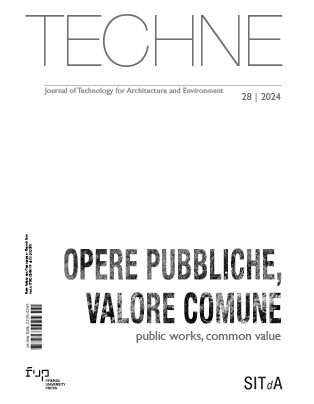Published 2024-10-29
Keywords
- In-between space,
- Nature-based solutions,
- Indicators,
- Project evaluation,
- Public space
How to Cite
Copyright (c) 2024 Marco Giampaoletti, Fabrizio Amadei, Maria Michaela Pani

This work is licensed under a Creative Commons Attribution 4.0 International License.
Abstract
The relationship between public works and communities highlights the inherently multidimensional theme of project and evaluation linked to indicators outlined in investment plans and territorial planning. Within this context, the climate crisis necessitates intervention in the city, where public space serves as an intermediate and proximity item, dynamically recalibrating urban interactions among people, nature, and technology. The objective of this paper is to investigate public space, identifying legislative criteria in terms of sustainability and the technological-environmental solutions present in the major environmental certification protocols currently available worldwide, as well as their application in national and international case studies. This analysis allows to define an original framework of dichotomous qualitative-quantitative indicators, simultaneously examining the limitations and future developments of the research. This contribution forms part of the research outcomes undertaken, both completed and ongoing, within the framework of the 2017 PRIN Research “Tech-Start” and the research line Mission 4 – Comp. 2 funded by the NRRP.
Downloads
References
- Baratta, A.F.L., Calcagnini, L., Finucci, F., Magarò, A. (2022), Gli indicatori di impatto nel Programma Innovativo Nazionale per la qualità dell’Abitare (PINQuA), Urban Crator TAT 2024. Available at: https://urbancuratortat.org/gli-indicatori-di-impatto-nel-programma-innovativo-nazionale-per-la-qualita-dellabitare-pinqua/#site-header (Accessed on 15/02/2024). DOI: https://doi.org/10.3280/TR2023-105002
- Berlingieri, F. (2021), “Prossimità, tempi e transizione. Due indirizzi progettuali per la città post pandemia”,Territorio, Vol.97, pp.27-34. Available at: https://journals.francoangeli.it/index.php/territorioOA/article/view/12924/1256 (Accessed on 05/06/2024). DOI: https://doi.org/10.3280/tr2021-097-Supplementooa12924
- Botchwey, N., Andrew L. Dannenberg A. L. and Frumkin H. (2022), Making Healthy Places. Designing and Building for Well-Being, Equity, and Sustainability, Island Press, Washington. Available at: https://islandpress.org/books/making-healthy-places-second-edition#desc (Accessed on 05/06/2024).
- Carmona, M. (2015), “Re-theorising contemporary public space: a new narrative and a new normative”, Journal of Urbanism: International Research on Placemaking and Urban Sustainability, Vol.8, issue 4, pp. 373-405. Available at: https://doi.org/10.1080/17549175.2014.909518. DOI: https://doi.org/10.1080/17549175.2014.909518
- Dawodu, A., Cheshmehzangi, A., Sharifi, A., Oladejo, J. (2022), “Neighborhood sustainability assessment tools: Research trends and forecast for the built environment”, Sustainable Futures, Vol.4. Available at: https://doi.org/10.1016/j.sftr.2022.100064. DOI: https://doi.org/10.1016/j.sftr.2022.100064
- European Commission (2020), A Renovation Wave for Europe – greening our buildings, creating jobs, improving lives, Brussels. Available at: https://ec.europa.eu/energy/sites/ener/files/eu_renovation_wave_strategy.pdf (Accessed on 17/02/2024).
- IPCC (2023), Synthesis Report Climate Change 2023, Cambridge University Press, Cambridge, UK and New York, NY, USA. Available at: https://www.ipcc.ch/report/ar6/syr/downloads/press/IPCC_AR6_SYR_SlideDeck.pdf (Accessed on 10/02/2024).
- Marrone, P. and Montella, I. (2022), “Edifici e spazi di prossimità per la transizione energetica – Una sperimentazione su limiti e potenzialità delle Comunità Energetiche Rinnovabili nella città costruita”, in Ferrante, T. and Tucci, F. (Eds), BASES Benessere Ambiente Sostenibilità Energia Salute – Programmare e progettare nella transizione, FrancoAngeli, Milano, pp. 347-355.
- MIMS – Ministero delle infrastrutture e delle mobilità sostenibili (2021), Programma innovativo nazionale per la qualità dell’abitare, Modello PINQuA. Available at: https://qualitabitare.mit.gov.it/docs/modellopinqua.pdf (Accessed on 11/01/2024).
- MIMS – Ministero delle infrastrutture e delle mobilità sostenibili (2022), Monitoraggio dell’attuazione del Piano Nazionale di Ripresa e Resilienza (PNRR) e del Piano Nazionale Complementare (PNC), 31 marzo 2022. Available at: https://www.mit.gov.it/nfsmitgov/files/media/notizia/202203/Conferenza%20stampa%2031.03.2022%20-%20Monitoraggio%20PNRR%20e%20PC_0.pdf (Accessed on 28/12/2023).
- Presidenza Consiglio dei ministri (2021), Indicatori Comuni Europei. Italia Domani, Piano Nazionale di Ripresa e Resilienza. Available at: https://www.italiadomani.gov.it/content/sogei-ng/it/it/Interventi/indicatori-comuni-europei.html (Accessed on 11/02/2024).
- Tucci, F. and Cecafosso, V. (2020), “Retrofitting dello spazio pubblico per la qualità ambientale ed ecosistemica di città più Green”, Techne – Journal of Technology for Architecture and Environment, Vol 19, pp.256-270. Available at: https://doi.org/10.13128/techne-7827.
- Tucci, F., Baiani, S., Altamura, P. and Cecafosso, V. (2021), “District Circular Transition e progetto tecnologico verso un modello di Circular City”, Techne – Journal of Technology for Architecture and Environment, Vol. 22, pp. 227-239. Available at: https://doi.org/10.36253/techne-10612. DOI: https://doi.org/10.36253/techne-10612
- UN (2015), Transforming Our World – The 2030 Agenda for Sustainable Development, Resolution adopted by the General Assembly on 25 September 2015, A/RES/70/1. Available at: https://sdgs.un.org/2030agenda (Accessed on 05/06/2024).
- Zamani, Z., Heidari, S., Hanachi, P. (2018), “Reviewing the Thermal and Microclimatic Function of Courtyards”, Renewable and Sustainable Energy Reviews, Vol. 93, pp.580-595. Available at: https://doi.org/10.1016/j.rser.2018.05.055. DOI: https://doi.org/10.1016/j.rser.2018.05.055






